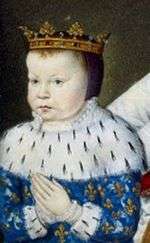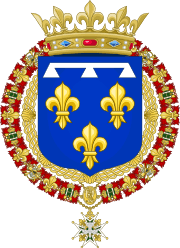Louis of Valois
| Louis | |
|---|---|
| Duke of Orléans | |
|
A depiction of the young prince in Catherine de' Medici's Book of Hours | |
| Duke of Orléans | |
| Reign | 3 February 1549 – 24 October 1550 |
| Predecessor | Charles II |
| Successor | Charles III |
| Born |
3 February 1549 Fontainebleau, Paris |
| Died |
24 October 1550 (age 1 year 8 months) Mantes-la-Jolie |
| Burial | Basilica of St Denis |
| House | Valois-Angoulême |
| Father | Henry II of France |
| Mother | Catherine de' Medici |
Louis de France (3 February 1549 – 24 October 1550), also known as Louis III, Duke of Orléans was the second son and fourth child of Henry II (31 March 1519 – 10 July 1559), King of France and his wife, Catherine de' Medici, daughter of Lorenzo II de' Medici, Duke of Urbino and his wife Madeleine de La Tour d'Auvergne. He died aged 1 year and 8 months.
Life
After their marriage, Henry and Catherine waited several years before having children. Various remedies were not effective until they, at least according to the voices of the court, turned to the court physician Fernel. In a matter of twelve years (since the birth of the Dauphin Francis in 1544 to the birth of Victoria and Joan in 1556), Catherine gave birth to ten children. Louis was born on 3 February 1549 at the Palace of Fontainebleau, as the second son and fourth child of Henry II of France and his Queen Consort, Catherine de' Medici, a member of the House of Medici. He was second in line to the throne, as his older sisters could not inherit under Salic law. Since birth, he was entrusted with the duchy of Orléans. Just like his older brother, he was given into the care of Diane de Poitiers, his father's possible mistress and reportedly shared the same nursery with his brother and sister, Francis and Elisabeth and later, his brother Charles. He was present when Mary, Queen of Scots arrived at Henry's court. She had come to marry Francis, the future King of France and King consort of Scots. There are reports that his parents had plans for Louis. They wanted him to become the future Duke of Urbino, a title which belonged exclusively to the Medici family.
Death
Freer's account
Freer's account states that Louis died in 1549, not 1550:
After receiving a splendid christening in October 1549, said to be of "extraordinary splendour"[1] in Saint-Germain-en-Laye,[1] a christening of fatal consequences to the infant prince,[1] Louis died at Mantes-la-Jolie, after the solemnity from the effects of a chill taken while being handed from one state functionary to another.[1] Catherine de' Medici submitted the more readily to the absence of her infant son.[1] The Parisians demonstrated their loyalty through a series of acts: the municipality gave a piece of bread to every poor person in Paris[1] and the citizens regaled by a display of fireworks on a grand scale in the Place facing the Hôtel de Ville.[1]
Other accounts
Other accounts dismiss Freer's, stating that Louis died in 1550, one even giving a date for his baptism, 19 May 1549 and listing his godparents as John III of Portugal, Mary of Guise and Ercole II d'Este, Duke of Ferrara.
Legacy
Had he lived, he would have ascended the throne in 1560, when his older brother died. Instead, his younger brother Charles became king, but he had just one daughter (who died aged six and it would have been impossible for her to succeed anyway, because she had been a girl), Marie-Elisabeth. His youngest brother Alexandre-Édouard became king, but he had no heirs and the House of Valois ceased to exist. Henry, King of Navarre became king (the first king from the House of Bourbon).
In fiction
He is briefly mentioned in the novel Madame Serpent and The Captive Queen, both by Jean Plaidy.
Ancestors
| Ancestors of Louis of Valois | ||||||||||||||||||||||||||||||||||||||||||||||||||||||||||||||||||||||||||||||||||||||||||||||||||||||||||||||||||||||||||||||||||||||||||||||||||||||||||||||||||||||||||||||||||||||||||||||||||||||||||||||||||||||||||||||||||||||||||||||||||||||||||||||||||||||||||||||||||||||||||||||||||||||||||||||||||||||||||||||||||||||||||||||||||||||||||||||||||||||||||||||||||||||||||||||||||||||||||||||||||||||||||||||||||||||||||||||||||||||||||||||||||||||||||||||||||||||||||||||||||||||||||||||||||||||||||||||||||
|---|---|---|---|---|---|---|---|---|---|---|---|---|---|---|---|---|---|---|---|---|---|---|---|---|---|---|---|---|---|---|---|---|---|---|---|---|---|---|---|---|---|---|---|---|---|---|---|---|---|---|---|---|---|---|---|---|---|---|---|---|---|---|---|---|---|---|---|---|---|---|---|---|---|---|---|---|---|---|---|---|---|---|---|---|---|---|---|---|---|---|---|---|---|---|---|---|---|---|---|---|---|---|---|---|---|---|---|---|---|---|---|---|---|---|---|---|---|---|---|---|---|---|---|---|---|---|---|---|---|---|---|---|---|---|---|---|---|---|---|---|---|---|---|---|---|---|---|---|---|---|---|---|---|---|---|---|---|---|---|---|---|---|---|---|---|---|---|---|---|---|---|---|---|---|---|---|---|---|---|---|---|---|---|---|---|---|---|---|---|---|---|---|---|---|---|---|---|---|---|---|---|---|---|---|---|---|---|---|---|---|---|---|---|---|---|---|---|---|---|---|---|---|---|---|---|---|---|---|---|---|---|---|---|---|---|---|---|---|---|---|---|---|---|---|---|---|---|---|---|---|---|---|---|---|---|---|---|---|---|---|---|---|---|---|---|---|---|---|---|---|---|---|---|---|---|---|---|---|---|---|---|---|---|---|---|---|---|---|---|---|---|---|---|---|---|---|---|---|---|---|---|---|---|---|---|---|---|---|---|---|---|---|---|---|---|---|---|---|---|---|---|---|---|---|---|---|---|---|---|---|---|---|---|---|---|---|---|---|---|---|---|---|---|---|---|---|---|---|---|---|---|---|---|---|---|---|---|---|---|---|---|---|---|---|---|---|---|---|---|---|---|---|---|---|---|---|---|---|---|---|---|---|---|---|---|---|---|---|---|---|---|---|---|---|---|---|---|---|---|---|---|---|---|---|---|---|---|---|---|---|---|---|---|---|---|---|---|---|---|---|---|---|---|---|---|---|---|---|---|---|---|---|---|---|---|---|---|---|---|---|---|---|---|---|---|---|---|---|---|---|---|---|---|---|---|---|---|---|---|---|---|---|---|---|---|---|---|---|---|---|---|---|---|---|---|---|---|---|---|---|---|---|---|---|---|---|---|---|---|---|---|---|---|---|---|---|---|---|---|---|---|---|---|---|---|---|---|---|---|---|---|---|---|---|
| ||||||||||||||||||||||||||||||||||||||||||||||||||||||||||||||||||||||||||||||||||||||||||||||||||||||||||||||||||||||||||||||||||||||||||||||||||||||||||||||||||||||||||||||||||||||||||||||||||||||||||||||||||||||||||||||||||||||||||||||||||||||||||||||||||||||||||||||||||||||||||||||||||||||||||||||||||||||||||||||||||||||||||||||||||||||||||||||||||||||||||||||||||||||||||||||||||||||||||||||||||||||||||||||||||||||||||||||||||||||||||||||||||||||||||||||||||||||||||||||||||||||||||||||||||||||||||||||||||
Sources
- Livre d’Heures de Catherine de Medicis 1556. Reproduced by kind permission of Bibliothèque Nationale Paris, Département de Manuscrits, B.N. n.a.l. 82) (nouvelles acquisitions latines).
- Freer, Martha Walker (1858). Henry III, King of France and Poland. Hurst and Blackett.
References
| Louis of Valois Cadet branch of the Capetian dynasty Born: 3 February 1549 Died: 24 October 1550 | ||
| French nobility | ||
|---|---|---|
| Preceded by Charles II |
Duke of Orléans as 'Louis III' 3 February 1549 – 24 October 1550 |
Succeeded by Charles III |

